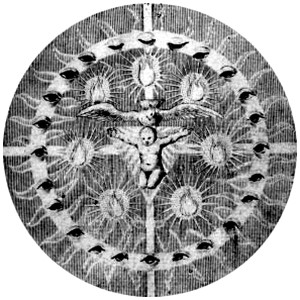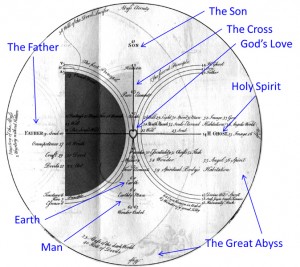Jakob Böhme was a Lutheran, born about a century after Martin Luther himself. While Böhme worked as a shoemaker, he also expressed his Christian faith using mandalas. He’s a strange, but interesting dude.
Böhme had divine visions, as did Hildegard von Bingen (still not saying where she is on the list!), and he wrote a lot. A lot. Some of his books survived, even to today. Many of his works have been translated into English and are available at the following sites:
http://pegasus.cc.ucf.edu/~janzb/boehme/ (may be slow)
Böhme’s associates either loved him or hated him. Some members of the clergy, during his time, called him a heretic. On the other hand, other clergy members, along with people in academia, revered him. Enough so that a movement called Behmenism formed, which followed Böhme and his teachings.
Often, Böhme’s books were illustrated with mandalas, and they were intriguing enough to catch Carl Jung’s attention. Jung discusses one of Böhme’s Christian mandalas in his book Mandala Symbolism, considered a classic. The Mandala that Jung analyzes was originally from Böhme’s Forty Questions Concerning the Soul, and is shown below. I’ve annotated the mandala in blue.
Böhme’s associates either loved him or hated him. Some members of the clergy, during his time, called him a heretic. On the other hand, other clergy members, along with people in academia, revered him. Enough so that a movement called Behmenism formed, which followed Böhme and his teachings.
Often, Böhme’s books were illustrated with mandalas, and they were intriguing enough to catch Carl Jung’s attention. Jung discusses one of Böhme’s Christian mandalas in his book Mandala Symbolism, considered a classic. The Mandala that Jung analyzes was originally from Böhme’s Forty Questions Concerning the Soul, and is shown below. I’ve annotated the mandala in blue.
Böhme’s mandalas typically use common Christian symbols and Hebrew letters. Some of his mandalas are difficult to decipher because he often does his own annotations on them, in German script. He also incorporates symbols from Alchemy (don’t think there are any gold mandalas though). To understand some of Böhme’s more complex mandalas requires someone with Jung’s breath of knowledge. However, some of the mandalas are more straight-forward, like the one at the top of this post.
At the center of this mandala is the incarnate Christ, depicted as a baby (a pretty cute one, I might add). He is drawn inside a triangle, a well-known Trinity symbol. Just above the baby Jesus is a dove, which is the Christian symbol for the Holy Spirit. Surrounding these components are seven flames, which suggest the imparting of wisdom to the Christ child. In Isaiah 11:1-2 we find the seven references to ‘the Spirit’:
1 There shall come forth a shoot from the stump of Jesse, and a branch from his roots shall bear fruit. 2 And the Spirit of the Lord shall rest upon him, the Spirit of wisdom and understanding, the Spirit of counsel and might, the Spirit of knowledge and the fear of the Lord.
Moving further out from the center of this mandala we find a circle full of eyes. The eyes look in all directions symbolic of an all knowing, ever present, God. The flames behind the circle may be a reference to another Old Testament prophecy found in Malachi 4:2,
2 But for you who fear my name, the sun of righteousness shall rise with healing in its wings. You shall go out leaping like calves from the stall (ESV).
Finally, behind all of these elements is the cross.
Check back on June 5th (this Sunday!) to see who is #6 on the list!


